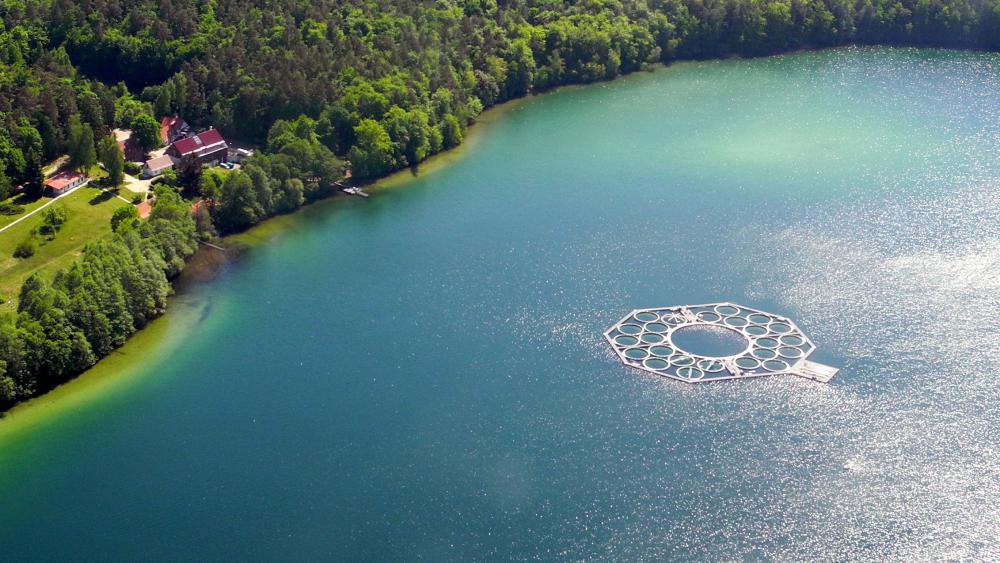
Aerial view of the BFS “Stechlin LakeLab” of the IGB: An experimental setup for researching the effects of climate change on aquatic organisms, their interactions and the ecological processes taking place within lakes. | © Peter Casper/IGB
Human activities are altering how the natural world functions. During the past decades, we have fundamentally and in most cases, irreversibly modified on a global scale the geosphere, hydrosphere, atmosphere, and particularly the biosphere. Biological field stations (BFS) constitute a worldwide infrastructure of strategic importance to monitor these global changes.
Based on a comprehensive inventory, scientists of the German Leibniz-Institute of Freshwater Ecology and Inland Fisheries (IGB) and the Cary Institute of Ecosystem Studies in Millbrook, NY, identified 1268 contemporary BFS, located in 120 countries. They are found in all biomes and focus on marine, terrestrial, and freshwater systems alike.
Most BFS are located in areas with low or intermediate human influence, like the Tundra Ecosystem Research Station situated in the Southern Arctic Ecozone in Canada. In contrast, few BFS are located in highly influenced areas like the Ecological Rhine Station situated on a former Rhine ship in Cologne, Germany. Klement Tockner, director of IGB and senior author of the study, emphasizes: “The rapid transformation of ecosystems worldwide calls for pertinent research and monitoring programs in human-dominated systems and in sensitive areas such as savannas, deserts, mountainous regions and offshore locations. Consequently, a concerted strategy should be developed to found BFS in such regions is required to enable monitoring, research, education, and information along distinct environmental and geopolitical gradients”.
Contemporary BFS exhibit a long and distinguished history. For example, the earliest BFS still in operation was founded in 1859 in Concarneau, France (Station de Biologie Marine). In 1920, already 55 of the present stations existed, primarily in Europe, North America and Japan. At the same time, BFS are under continuous risk of closure because of financial insecurity, lack of public understanding and support, and weak governance.
The majority of the BFS is administratively tied to universities and colleges. But also museums and non-university research institutions, non-governmental and non-profit organizations, and governmental institutions including national parks run BFS. Host institutions together with funding organizations and politicians need to develop sustainable concepts to maintain BFS as a critical infrastructure of regional and global importance. Likewise, BFS need to increase their information flow, provide access to data resources and long-term data sets. Sharing infrastructure facilities and expensive mobile instrumentation, and enhancing research capacity and financial efficiency will strengthen BFS.
Klement Tockner underlines: “We urgently need solid, long-term data on the rapid global changes to set clear priorities in environmental management. BFS may offer long-term commitment in supporting global programs and networks such as the Intergovernmental Platform on Biodiversity and Ecosystem Services (IPBES), and the Global Lake Ecological Observatory Network (GLEON). This unique opportunity shall not be missed”.
Furthermore, the hands-on contribution of BFS to the education of undergraduate and graduate students in environmental research is of tremendous value in a way that cannot be approached on a university campus. In this respect, BFS must continue to play a fundamental role in educating the next generation of environmental scientists.
Gene E. Likens, Founding Director and President emeritus of the Cary Institute of Ecosystem Studies in Millbrook, NY points out the critical need to sustain and expand the unique opportunities for monitoring, research, teaching and training that BFS provide. BFS are biological “treasures” that need our support and protection.
The database on biological field stations is integrated in the Freshwater Information Platform.




